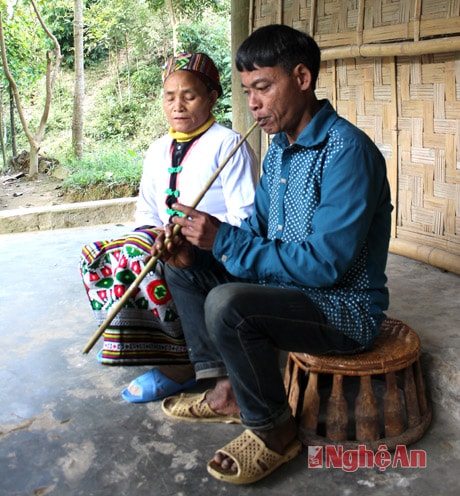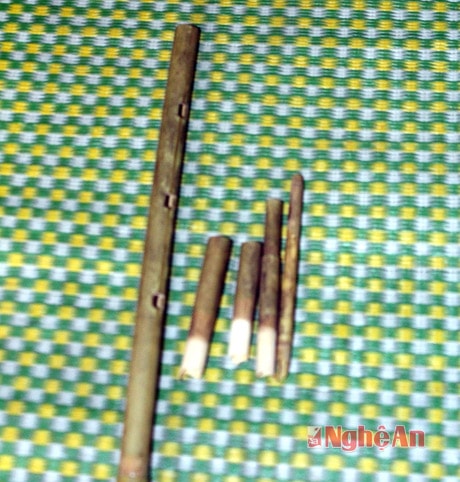Pi tom, a unique musical instrument of the Khmu people
(Baonghean) - DBecause of the practice of slash-and-burn cultivation and a lifestyle closely tied to nature, the Khmu people's culture always bears the strong imprint of the mountains and forests, vividly expressed in their daily life, traditional costumes, folk music and weaving art.
If anyone has ever been to the mountainous districts of Ky Son, Tuong Duong, Que Phong, and visited the villages of the Khmu people, they will be immersed in the performance space of traditional festivals...
 |
| Pi tom, a unique musical instrument of the Khmu people. |
The Khmu have many folk melodies that are both clear and strong, with a singing style imbued with epic qualities, rich in images of trees and streams. These are the "tom" melodies (i.e. love songs) as moving as the cooing of birds every spring morning, calling for rain for trees to sprout, for crops to flourish, for couples to date and become husband and wife; to enjoy the same fields, enjoy the red fire of "Tam bra", like a pair of doves that stick together for life. Along with the "tom" melodies, when going to the fields or going to the market... the Khmu sing the "Kun cho" melodies (i.e. calling songs while on the road), resonant and strong like the echoes of the great forest.
Contributing to the captivating beauty of Khmu folk songs are the unique musical instruments. In the rich musical instrument system of the Khmu people, up to 90% are made from bamboo, with unique tones that are both deep like the green forest and cheerful like the kind, loyal soul, in harmony with nature and love of dancing and singing.
 |
| Pi tom tree |
Musical instruments with the soul of bamboo and reed can accompany the singing of "Tom" and "Kun Cho", and can be the cheerful background music for dances in community festivals such as "Te ca grang" (fish dance), "Te ro voet" (scarf dance), "Te men pi ham me" (spring dance)... Unique musical instruments made from bamboo and reed of the Khmu people that still appear a lot in the lives of the people today are Oom ding, Dao, tot, Pi tom.
The Oom ding, originally a water pipe made from bamboo tubes, has a warm, resonant sound scale with the function of keeping the rhythm. The Dao was originally a tool to scare birds away from eating rice seeds during the sowing season. It was made from bamboo tubes. When played, it creates a series of double sounds that vibrate and whisper, both near and far. The Tot is a vertical flute with 4 or 6 holes.
When talking about the most unique and always attached to the cultural life of the Khmu people, we cannot help but mention the Pi tom tree. This is a type of vertical flute, similar to the "Pi" of the Thai people, with a unique timbre like the sound of the wind whistling through the hillsides, valleys and has the ability to express moods, simulating the living space of the Khmu people on the hillsides of the highlands of Nghe An. Pi tom is the main musical instrument used to accompany "Tom" singing, "Kưn cho" singing and contributes timbre to the bamboo musical ensemble to enrich the collective singing and dancing performances during festivals, is the deep voice of the soul, feelings and good wishes about life and love of the Khmu people, so people often call it in the Thai way, Pi tom tree.
Pi tom is crafted in a simple way. The Khmu people can make this unique musical instrument anywhere, as long as they only need a small bamboo tree with a diameter of 1-1.5cm. The bamboo tree used to make Pi tom must be old enough, not too old. The artisan cuts 7 bamboo segments, each 8cm long, trims them and then threads them together in order of size. The third segment from the base, about 24cm long, has 3 holes drilled slightly apart, 6-7cm apart, the 7th tube (the top) is only as small as a chopstick with a reed. Unlike the Thai Pi nhuon (which has a brass reed), the reed of the Pi tom is made from the bamboo tree itself. The artisan uses a sharp knife to strip off the bamboo, then carves out the reed, about 1.5cm long and 2mm wide. When blown, the reed vibrates gently to regulate the sound through small holes, creating melodies imbued with the sounds of the great forest.
From bamboo trees, through the skillful hands and passionate soul of the Khmu men, they created melodies that were sometimes bustling, sometimes deep. That harmony sounded like the sound of a stream, the sound of the wild wind, the sound of forest birds calling for their friends and the sound of hesitant footsteps. That is the soul, the voice of the Khmu people, a people who still face many difficulties on the path of development but whose souls are always joyful and full of faith.
The stilt houses are built from forest trees, the scarves and shirts are dark green in the forest, the innocent and pure folk songs and musical instruments carry the familiar and mountain sounds. The soul of bamboo will forever be the pride of the unique cultural identity of the Khmu people - the honest, loyal people who always know how to beautify their lives and souls from the seemingly simple but extremely precious things that the green mountains have bestowed. The beloved mountains and forests not only provide the Khmu people with a source of life for generations, but also contribute significantly to creating the extremely unique cultural mark of this nation!
Vi Hoi(Xiangyang)


